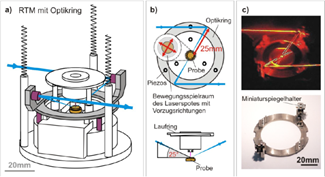Investigation of the water gas shift reaction by spatially and time resolved pump-probe experiments
The aim of this work is the setup of a pump-probe experiment, combining the high time resolution (fs = 10-15 s) of a laser with the high spatial resolution (100 pm = 10‑10 m) of a scanning tunneling microscope (STM). Pump-probe experiments use ultra-short laser pulses to excite the sample in a first step. After a certain delay time, another laser pulse is used to transfer the sample to another excited state. In our case, the two resulting excited states are measured using the STM at temperatures as low as 5 K. The excitation process is tracked in real time by varying the time delay of the laser pulses.
Fig. 1: a) Schematic setup of the laser coupling into the tunneling pathway of the STM: The laser beam (blue) is focussed onto the sample (yellow) by a set of mirrors (purple), b) Schematic view of the laser taple (top-view and side-view), c) photograph of the optical ring with miniature mirror holders with (top) and without (bottom) laser light [Mehlhorn et al., Rev. Sci. Instrum. 78, 033905 (2007)].
In general, the investigated systems are composed of adsorbates on metal substrates. The setup depicted above is used to observe the pathway and the time-scale of the energy transport from the laser to the adsorbate. In this project, the reaction pathway of the water gas shift reaction (CO + H2O à H2 + CO2) is investigated on a Cu(111) single crystal surface acting as the catalyst/substrate.
Sound interesting? Wanna know more about it?Please contact: michael.vyshnepolsky@rub.de

